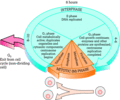Chapter 23: Administration of systemic anticancer therapies
Skip chapter table of contents and go to main content

Related theory
Cytotoxic drugs
The term ‘cytotoxic’, literally translated, means ‘toxic to cells’. Hence cytotoxic drugs are those which kill cells (malignant or non‐malignant). Chemotherapy works by disrupting cellular growth and causing damage to DNA, RNA and proteins (Dougherty and Bailey [61], Skeel [236]). The aim of chemotherapy is to prevent cancer cells multiplying, invading or metastasizing, and optimizing survival (Skeel [236]).
All proliferating cells (normal cells and cancer cells) go through the same division cycle (Figure 23.1). The cell cycle is a series of phases through which cells must pass as they replicate (Dougherty and Bailey [61]). The DNA in a parent cell replicates and divides, producing two daughter cells.
- Following cell division or mitosis (M) (which occurs within an hour), cells enter the first gap or G phase, where cells prepare to synthesize DNA but where synthesis of RNA and protein occurs.
- The next phase, called the S phase or synthesis phase (which occurs within 10–20 hours), results in the cells doubling their DNA content. Many cytotoxic drugs work by disrupting the genetic codes during DNA synthesis.
- The second gap or G2 phase (can last from 2 to 10 hours) is where the cell is preparing for division. DNA synthesis stops while RNA synthesis and protein synthesis continue in preparation for mitosis (Yarbro et al. 2016).
- Mitosis occurs in the final stage of the cell cycle, M phase, and can last from 30 to 90 minutes. At the end of this phase, cells either rejoin the cell cycle at G or enter the resting subphase G0.

Figure 23.1 The cell cycle. Source: Adapted from Tortora and Derrickson ([246]). Reproduced with permission of John Wiley & Sons.
Cancer chemotherapy drugs tend to be administered in combination, which means that they can act upon different phases of the cell cycle, thus producing maximum cytotoxic effect. Many drugs are licensed for the treatment of cancer and most of these (with the exception of antihormonal drugs used to treat breast and prostate cancers) target rapidly dividing cells, either through the effects on DNA or factors involved in mitosis (Kelland [121]). A greater understanding of the molecular biology of both normal and cancer cells has resulted in significant developments in targeting mechanisms of tumour growth, invasion and metastasis.
Cancer immunology
This relates to the interactions between the immune system and cancer cells. The functioning of the immune system has an impact upon the development and management of cancer (Yarbro et al. 2016). The immune system functions as a result of different organs and tissues (bone marrow, spleen, thymus, circulatory and lymphatic system) working together to prevent infection. There are two types of immune response, based on their roles in response to an antigen: innate and adaptive (Polovich et al. [194]). The first response, which involves neutrophils, monocytes, macrophages and large granular lymphocytes, does not produce an immunological memory whereas the secondary adaptive response, involving lymphocytes, B cells and T cells, has a specific memory.
Cells in the immune system express proteins on the surface of the cell membrane which are referred to as markers or clusters of differentiation (CD) (Yarbro et al. 2016). These markers, such as CD4 and CD20, are used to create cell‐specific therapy which is prevalent in the management of cancer.
Biological and molecular targeted therapy
Molecular targeted therapy (MTT) is a new aspect of cancer treatment that has resulted from the vast number of molecular and biological advances into the aetiology of cancer over the last few decades (Skeel [236]). These drugs have been developed to specifically target molecules that are uniquely or abnormally expressed within cancer cells whilst sparing normal cells. Once the targeted molecule has been switched off, the cancer cell is not able to develop a resistance to the therapeutic agent. There are two different classifications of MMT based upon each molecule's targeting strategy: function‐directed therapy, which targets specific cellular pathways, and phenotype‐directed therapy, which targets the unique phenotype of the cancer cell relying on non‐specific mechanisms to kill the cancer cells (Skeel [236]). Epidermal growth factor receptors (EGFRs) are proteins that belong to the larger tyrosine kinase family. In a healthy cell, EGFRs allow cells to grow and divide, however too many receptors caused by a mutation or cancer allow the cancer cells to grow and divide. Tyrosine kinase inhibitors block EGFRs from working and therefore can slow or stop tumour growth. Examples of drugs that inhibit EGFRs are cetuximab, panitumumab, trastuzumab, pertuzumab and bevacizumab.
Hormone agents
The hormone agents that are used to treat cancer include steroids, oestrogens, progestins, androgens, corticoids and their synthetic derivatives, non‐steroidal compounds with steroid or steroid‐antagonist activity, aromatase inhibitors, hypothalamic–pituitary analogues and thyroid hormones (Toumeh and Skeel [247]).





